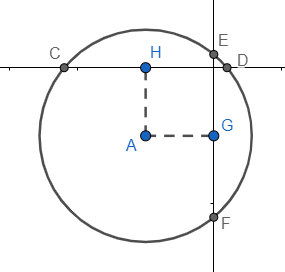
A circle cuts two perpendicular lines so that each intercept is of given length. The locus of the centre of the circle is a conic whose eccentricity is
A) 1
B)
C)
D) None of these.
Answer
516.9k+ views
Hint: Let the two perpendicular lines be the x-axis and the y-axis, and let the intercepts be equal to a and b, respectively. Assume the centre of the circle to be (x,y). Use the property that the perpendicular from the centre of the circle divides the chord into two equal halves.
Complete step-by-step answer:
Let us start the solution by letting the two perpendicular lines be the x-axis and the y-axis, and the intercepts be equal to a and b, respectively. We will also assume the centre of the circle to be (x,y).
Let us draw the diagram of the situation according to the assumed data.

Now, as we have considered A to be (x,y) , the point H comes out to be (x,0) and G comes to be (0,y).
Also, according to our assumption, CD=a and EF=b and they are the chords of the circle.
Now we know that the perpendicular from the centre of the circle divides the chord into two equal halves. So, we can say that HD =
Now, according to the distance formula, the distance between two points
So, using the figure and above result, we can say that
If we square both sides of the equation, we get
So, looking at the equation, we can say that the locus of the centre is a hyperbola with the length of major axis=length of the minor axis. We know that the eccentricity of a hyperbola is given by:
Therefore, the answer to the above question is option (c).
Note: You could have also solved the question by taking any two perpendicular lines, but considering the axes as the lines is the smartest way of approaching the above problem. Also, be sure that you learn all the properties and theorems related to circles as they are used very often.
Complete step-by-step answer:
Let us start the solution by letting the two perpendicular lines be the x-axis and the y-axis, and the intercepts be equal to a and b, respectively. We will also assume the centre of the circle to be (x,y).
Let us draw the diagram of the situation according to the assumed data.

Now, as we have considered A to be (x,y) , the point H comes out to be (x,0) and G comes to be (0,y).
Also, according to our assumption, CD=a and EF=b and they are the chords of the circle.
Now we know that the perpendicular from the centre of the circle divides the chord into two equal halves. So, we can say that HD =
Now, according to the distance formula, the distance between two points
So, using the figure and above result, we can say that
If we square both sides of the equation, we get
So, looking at the equation, we can say that the locus of the centre is a hyperbola with the length of major axis=length of the minor axis. We know that the eccentricity of a hyperbola is given by:
Therefore, the answer to the above question is option (c).
Note: You could have also solved the question by taking any two perpendicular lines, but considering the axes as the lines is the smartest way of approaching the above problem. Also, be sure that you learn all the properties and theorems related to circles as they are used very often.
Latest Vedantu courses for you
Grade 11 Science PCM | CBSE | SCHOOL | English
CBSE (2025-26)
School Full course for CBSE students
₹41,848 per year
Recently Updated Pages
Master Class 11 Economics: Engaging Questions & Answers for Success

Master Class 11 Business Studies: Engaging Questions & Answers for Success

Master Class 11 Accountancy: Engaging Questions & Answers for Success

Master Class 11 English: Engaging Questions & Answers for Success

Master Class 11 Computer Science: Engaging Questions & Answers for Success

Master Class 11 Maths: Engaging Questions & Answers for Success

Trending doubts
State and prove Bernoullis theorem class 11 physics CBSE

1 ton equals to A 100 kg B 1000 kg C 10 kg D 10000 class 11 physics CBSE

State the laws of reflection of light

One Metric ton is equal to kg A 10000 B 1000 C 100 class 11 physics CBSE

1 Quintal is equal to a 110 kg b 10 kg c 100kg d 1000 class 11 physics CBSE

Difference Between Prokaryotic Cells and Eukaryotic Cells




